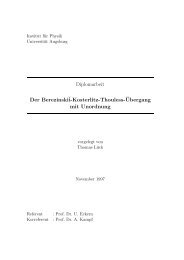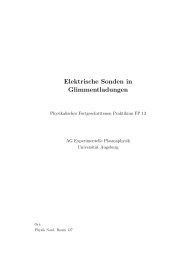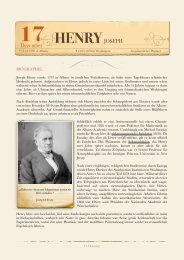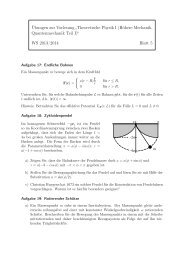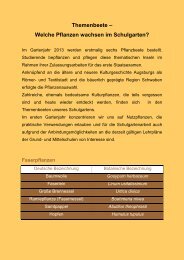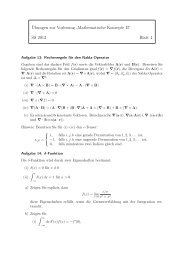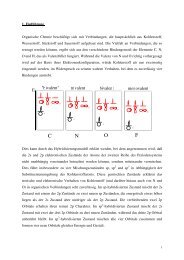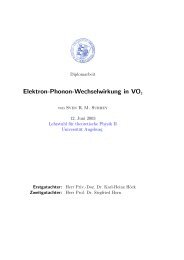Nuclear Magnetic Resonance Spectroscopy
Nuclear Magnetic Resonance Spectroscopy
Nuclear Magnetic Resonance Spectroscopy
Create successful ePaper yourself
Turn your PDF publications into a flip-book with our unique Google optimized e-Paper software.
<strong>Nuclear</strong> <strong>Magnetic</strong> <strong>Resonance</strong> <strong>Spectroscopy</strong>
History<br />
1940‘s first evidence for NMR signals (1945)<br />
1950‘s explanation of the influence on the chemical<br />
environment on the shift of NMR signals<br />
1952 Noble prize for Bloch/Purcell for developing<br />
NMR spectroscopy<br />
1960‘s improvement of sensitivity by multiple<br />
measurements and Fuorier-Transformation<br />
evaluation<br />
1970‘s improvement of resolution by application of<br />
supraconducting magnets yielding in higher field<br />
strengths<br />
1980‘s development of multidimensional methods<br />
1990‘s development of pulsed field gradient methods<br />
2000‘s Coupling of NMR with chromatographic methods<br />
development of even higher fields of the magnets
N<br />
-<br />
+<br />
p<br />
p<br />
n<br />
+<br />
-<br />
S<br />
Particle<br />
Charge<br />
Spin<br />
<strong>Magnetic</strong> Moment<br />
(relative)<br />
Gyromagnetic<br />
constant γ<br />
10 -7 rad T -1 s -1<br />
Proton<br />
+1<br />
½<br />
+1.6<br />
26.8<br />
Neutron<br />
0<br />
½<br />
-1<br />
-18.3<br />
Electron<br />
-1<br />
½<br />
-1060<br />
-17608
102<br />
No<br />
-<br />
101<br />
Md<br />
-<br />
100<br />
Fm<br />
-<br />
99<br />
Es<br />
-<br />
98<br />
Cf<br />
-<br />
97<br />
Bk<br />
-<br />
96<br />
Cm<br />
-<br />
95<br />
Am<br />
-<br />
94<br />
Pu<br />
-<br />
93<br />
Np<br />
-<br />
92<br />
U<br />
-<br />
91<br />
Pa<br />
-<br />
90<br />
Th<br />
-<br />
89<br />
Ac<br />
-<br />
*<br />
*<br />
**Actinoids<br />
70<br />
173 Yb<br />
14.3<br />
69<br />
169 T<br />
m<br />
100<br />
68<br />
Er<br />
-<br />
67<br />
Ho<br />
-<br />
66<br />
Dy<br />
-<br />
65<br />
Tb<br />
-<br />
64<br />
Gd<br />
-<br />
63<br />
Eu<br />
-<br />
62<br />
Sm<br />
-<br />
61<br />
Pm<br />
-<br />
60<br />
Nd<br />
-<br />
59<br />
Pr<br />
-<br />
58<br />
Ce<br />
-<br />
57<br />
La<br />
-<br />
*<br />
*Lanthanoids<br />
118<br />
Uuo<br />
-<br />
117<br />
Uus<br />
-<br />
116<br />
Uuh<br />
-<br />
115<br />
Uup<br />
-<br />
114<br />
Uuq<br />
-<br />
113<br />
Uut<br />
-<br />
112<br />
Uub<br />
-<br />
111<br />
Rg<br />
-<br />
110<br />
Ds<br />
-<br />
109<br />
Mt<br />
-<br />
108<br />
Hs<br />
-<br />
107<br />
Bh<br />
-<br />
106<br />
Sg<br />
-<br />
105<br />
Db<br />
-<br />
104<br />
Rf<br />
-<br />
103<br />
Lr<br />
-<br />
*<br />
*<br />
88<br />
Ra<br />
-<br />
87<br />
Fr<br />
-<br />
7<br />
86<br />
Rn<br />
-<br />
85<br />
At<br />
-<br />
84<br />
Po<br />
-<br />
83<br />
Bi<br />
-<br />
82<br />
207 Pb<br />
22.6<br />
81<br />
205 Tl<br />
70.5<br />
80<br />
Hg<br />
-<br />
79<br />
Au<br />
-<br />
78<br />
195 Pt<br />
33.8<br />
77<br />
Ir<br />
-<br />
76<br />
187 Os<br />
1.6<br />
75<br />
Re<br />
-<br />
74<br />
183 W<br />
14.4<br />
73<br />
Ta<br />
-<br />
72<br />
Hf<br />
-<br />
71<br />
Lu<br />
-<br />
*<br />
56<br />
Ba<br />
-<br />
55<br />
Cs<br />
-<br />
6<br />
54<br />
129 Xe<br />
26.4<br />
53<br />
I<br />
-<br />
52<br />
125 Te<br />
7.0<br />
51<br />
Sb<br />
-<br />
50<br />
119 Sn<br />
8.6<br />
49<br />
In<br />
-<br />
48<br />
111 Cd<br />
12.8<br />
47<br />
107 Ag<br />
51.8<br />
46<br />
Pd<br />
-<br />
45<br />
103 Rh<br />
100<br />
44<br />
Ru<br />
-<br />
43<br />
Tc<br />
-<br />
42<br />
Mo<br />
-<br />
41<br />
Nb<br />
-<br />
40<br />
Zr<br />
-<br />
39<br />
89 Y<br />
100<br />
38<br />
Sr<br />
-<br />
37<br />
Rb<br />
-<br />
5<br />
36<br />
Kr<br />
-<br />
35<br />
Br<br />
-<br />
34<br />
Se<br />
-<br />
33<br />
As<br />
-<br />
32<br />
Ge<br />
31<br />
Ga<br />
-<br />
30<br />
Zn<br />
-<br />
29<br />
Cu<br />
-<br />
28<br />
Ni<br />
-<br />
27<br />
Co<br />
-<br />
26<br />
57 Fe<br />
2.2<br />
25<br />
Mn<br />
-<br />
24<br />
Cr<br />
-<br />
23<br />
V<br />
-<br />
22<br />
Ti<br />
-<br />
21<br />
Sc<br />
-<br />
20<br />
Ca<br />
-<br />
19<br />
K<br />
-<br />
4<br />
18<br />
Ar<br />
-<br />
17<br />
Cl<br />
-<br />
16<br />
S<br />
-<br />
15<br />
31 P<br />
100<br />
14<br />
29 Si<br />
4.7<br />
13<br />
Al<br />
-<br />
12<br />
Mg<br />
-<br />
11<br />
Na<br />
-<br />
3<br />
10<br />
Ne<br />
-<br />
9<br />
19 F<br />
100<br />
8<br />
O<br />
-<br />
7<br />
15 N<br />
0.3<br />
6<br />
13 C<br />
1.1<br />
5<br />
B<br />
-<br />
4<br />
Be<br />
-<br />
3<br />
Li<br />
-<br />
2<br />
2<br />
He<br />
-<br />
1<br />
1 H<br />
100<br />
1<br />
Period<br />
18<br />
17<br />
16<br />
15<br />
14<br />
13<br />
12<br />
11<br />
10<br />
9<br />
8<br />
7<br />
6<br />
5<br />
4<br />
3<br />
2<br />
1<br />
Group<br />
The number below the element symbol shows the natural abundance of the isotope with I=1/2 in %
Energy<br />
Magn. field strength
Energy<br />
Magn. field strength<br />
Magn. field strength<br />
Energyabsorption<br />
Energyabsorption<br />
Energyabsorption
Energy<br />
Frequency ν<br />
Energy<br />
Energy<br />
absorption<br />
Frequency ν<br />
Energy<br />
Energyabsorption<br />
Magn. field strength<br />
Energyabsorption
1 frequency at once<br />
5 frequencies at once<br />
1.5<br />
1<br />
0.5<br />
0<br />
0 1 2 3 4 5 6 7<br />
-0.5<br />
-1<br />
-1.5<br />
10<br />
8<br />
6<br />
4<br />
2<br />
0<br />
0<br />
-2<br />
1 2 3 4 5 6 7<br />
-4<br />
-6<br />
-8<br />
-10<br />
100 frequencies at once<br />
250 frequencies at once<br />
80<br />
70<br />
60<br />
50<br />
40<br />
30<br />
20<br />
10<br />
0<br />
0<br />
-10<br />
1 2 3 4 5 6 7<br />
-20<br />
-30<br />
100<br />
80<br />
60<br />
40<br />
20<br />
0<br />
0 1 2 3 4 5 6 7<br />
-20<br />
-40
Energy differencies in NMR spectroscopy (intensity of signals)<br />
<strong>Magnetic</strong> Energy<br />
∆E = h ν = ħ γ B ≈ 4 10 -25 J<br />
Thermal Energy<br />
E = k T ≈ 4 10 -21 J<br />
∆E<br />
m=½<br />
∆E = h ν<br />
B<br />
n m=½<br />
-<br />
n m=-½<br />
=e<br />
∆E<br />
k T<br />
≈ 0.9999<br />
m=-½
Comparison of energies in spectroscopy<br />
Electromagnetic Wave length Frequency Properties to be examined Spectroscopic method<br />
irradiation<br />
γ rays 100 pm – 1 pm 3 10 18 – 3 10 20 Hz Change of nuclear states γ-<strong>Spectroscopy</strong>, Mößbauer-<br />
<strong>Spectroscopy</strong><br />
x-rays 10 nm – 100 pm 3 10 16 – 3 10 18 Hz Change of state of inner electron x-ray <strong>Spectroscopy</strong><br />
core state<br />
UV light, visible light 1 µm – 10 nm 3 10 14 – 3 10 16 Hz Change of state of avlence UV <strong>Spectroscopy</strong><br />
electrons<br />
Infrared rays 100 µm – 1 µm 3 10 12 – 3 10 14 Hz Change of vibrational<br />
IR/Raman <strong>Spectroscopy</strong><br />
states<br />
Microwaves 1 cm – 100 µm 30 GHz – 3 10 12 Hz Change of rotational<br />
Microwave <strong>Spectroscopy</strong><br />
states<br />
Microwaves 1m – 1 cm 300 MHz – 30 GHz Change of electron spin Electron spin resonance (ESR)<br />
states<br />
Radiowaves 100 m – 1 m 3 MHz – 300 MHz Change of nuclear spin<br />
states<br />
<strong>Nuclear</strong> spin resonance (NMR)
IR spectroscopy<br />
13<br />
C-NMR
N<br />
B<br />
B'<br />
M<br />
S<br />
emitter<br />
coil<br />
receiver<br />
coil M=0<br />
N<br />
B'<br />
M<br />
S<br />
rotating angle is<br />
dependent of<br />
irradiation time and<br />
irradiation power<br />
receiver<br />
coil M>0<br />
N<br />
B'<br />
M<br />
S<br />
emitter<br />
coil<br />
emitter<br />
coil
Line broadening (relaxation)<br />
A. spin-lattice relaxation T 1 :<br />
receiver<br />
static magnetic field<br />
transmitter<br />
B z<br />
receiver<br />
T 1<br />
B y<br />
transmitter<br />
static magnetic field<br />
B z<br />
receiver<br />
B. spin-spin relaxation T 2 :<br />
transmitter<br />
B z<br />
B z<br />
T 2<br />
B z<br />
∆E ∆t ≥ ħ<br />
B y<br />
B y
Molecular<br />
vibration<br />
Dynamic<br />
Process<br />
Chemical<br />
exchange processes<br />
Molecular<br />
Rotation<br />
Macroscopic<br />
transport processes<br />
slow<br />
s ms µs ns ps fs<br />
fast<br />
Spectroscopic<br />
Finding<br />
slow<br />
exchange<br />
Longitudinal<br />
Magnetization exchange<br />
Line wideperturbation<br />
fast<br />
exchange<br />
The NMR time scale<br />
Relaxation<br />
time scale<br />
Spectral<br />
time scale<br />
Larmortime<br />
scale
<strong>Resonance</strong><br />
frequency<br />
ν Α,Ref.<br />
bare nucleus A<br />
nucleus A<br />
with electron density<br />
e<br />
nucleus A<br />
with more electron densitiy<br />
δ<br />
e<br />
chemical<br />
shift<br />
ν Β,Ref.<br />
bare nucleus B nucleus B<br />
with electron density<br />
e<br />
δ<br />
nucleus B<br />
with more electron density<br />
e
Position of the signal (chemical shift)<br />
δ = ν obs - ν ref<br />
ν ref
Factors influencing the chemical shift (ring current)<br />
δ ≈ 7.2 ppm
Spectrum:<br />
ν 0 ν 1 ν 1<br />
β(β)<br />
H<br />
β<br />
β<br />
β(α)<br />
C<br />
O<br />
H<br />
ν 0 ν 1<br />
ν 1<br />
ν 1<br />
α<br />
α<br />
α(β)<br />
α(α)<br />
bare nucleus<br />
chemical<br />
shift<br />
of electronic<br />
environment<br />
chemical<br />
shift<br />
additionally by<br />
spin environment
Fine structure of the signal (indirect scalar spin-spin coupling)
Spectrum:<br />
ν 0<br />
ν 1 ν 2 ν 1 ν 2 ν 1a/b ν 2a/b<br />
β<br />
β(β)<br />
β(α)<br />
β@β<br />
β@α<br />
β(β)<br />
β@β<br />
H<br />
Cl<br />
β<br />
β<br />
β(α)<br />
β@α<br />
C<br />
N<br />
H<br />
ν<br />
ν 2b<br />
ν 2<br />
ν 2 ν<br />
0 ν 1 ν 1b<br />
1 ν 2a<br />
ν 2 ν 1 ν 1a<br />
α<br />
α<br />
α(β)<br />
α(α)<br />
α@β<br />
α@α<br />
bare nucleus<br />
α<br />
chemical<br />
shift<br />
of electronic<br />
environment<br />
α(β)<br />
α(α)<br />
chemical<br />
shift<br />
additionally by<br />
spin environment<br />
α@β<br />
α@α<br />
additionally active<br />
coupling between<br />
spins
Fine structure of the signal (indirect scalar spin-spin coupling)
1<br />
J-coupling M─X:<br />
Factors influencing the coupling constant<br />
•Oxidation number of M: the higher the Ox-number of M the smaller 1 J MX<br />
•trans-Ligand to M─X: the stronger the trans-influence of the trans-Ligand to M─X the smaller 1 J MX<br />
•Hybridisation of X: the larger the s-amount in the bonding orbital the larger 1 J MX<br />
•Coordination number: the larger the coordination number the smaller 1 J MX<br />
•Gyromagnetic constant: The larger γ M<br />
and γ X<br />
the larger 1 J MX<br />
2<br />
J-coupling X─M─Y:<br />
trans-coupling > cis-coupling<br />
p sp 3 sp 2 sp<br />
90° 109° 120° 180°<br />
1 J RhP =140.7 Hz<br />
2 J PP c=19.8 Hz<br />
2 J PP c=57.5 Hz<br />
Ph Ph<br />
P<br />
O<br />
Rh<br />
O<br />
P<br />
Ph<br />
Ph<br />
P<br />
O<br />
1 J RhP =168.4 Hz<br />
2 J PP c=19.8 Hz<br />
2 J PP t=340.9 Hz<br />
2 J-coupling constant increases<br />
1 J RhP =170.4 Hz<br />
2 J PP c=57.5 Hz<br />
2 J PP t=340.9 Hz<br />
3<br />
J-coupling X─A─B─Y:<br />
φ HCOP =60°<br />
3<br />
J HP =0 Hz<br />
X φ<br />
Y<br />
1 J PPt =2627.5 Hz<br />
φ HCOP =25°<br />
3 J HP =8 Hz<br />
3 J XY = A cos (2 φ) + B cos (φ) + C<br />
1 J PPt =4267.2 Hz<br />
Minimum for φ=60°<br />
Maximum for φ between 0-30° bzw. 150-180°
Information content of a 1D NMR spectrum<br />
Line width of the signal:<br />
life time of the spin state<br />
in the specific environment<br />
Intensity of the signal:<br />
amount of nuclei with<br />
specific environment<br />
Fine structure of the signal:<br />
neighboring nuclear spins<br />
Position of the signal:<br />
electronic environment of the nucleus
Fine structure of the signal (decoupling)<br />
F<br />
F<br />
As<br />
F<br />
Me<br />
Me
Fine structure of the signal (indirect scalar spin-spin coupling)
Fine structure of the signal (indirect scalar spin-spin coupling)
Fine structure of the signal (natural abundance)
Line broadening (Chemical exchange)
Hidden Coordination Sites (Jahn-Teller-Effect)<br />
E<br />
D 4h<br />
C 2v<br />
D 3h<br />
L<br />
L<br />
L<br />
L<br />
M<br />
L<br />
-L<br />
L<br />
M<br />
L<br />
M<br />
L<br />
L<br />
L<br />
High T<br />
31<br />
P-NMR<br />
Low T<br />
a<br />
b
line braodening (exchange decoupling)<br />
13<br />
C-NMR<br />
(3)<br />
(2)<br />
(1)<br />
(3): after addition of much CO<br />
(2): after addition of some CO<br />
(1): starting situation (without additional CO)
Solid state NMR spectroscopy



